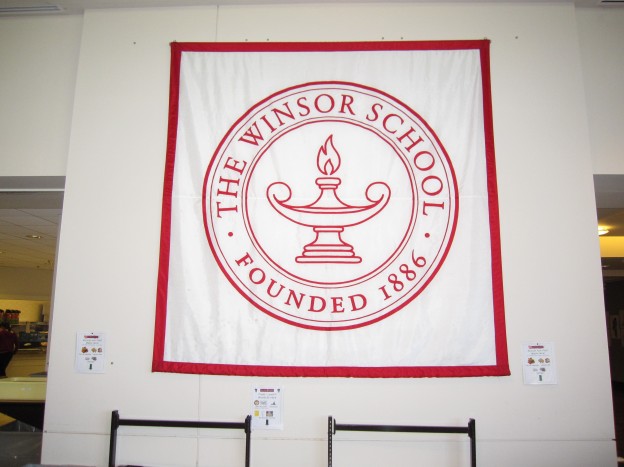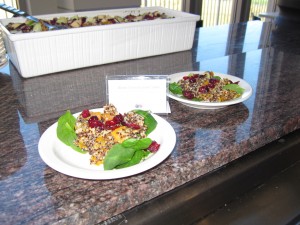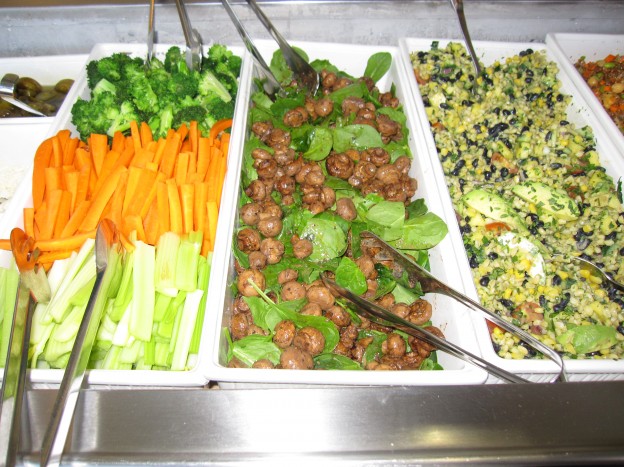
Winsor School banner above the Dining Hall tray station (all photos: Sue McCrory)
Late in 2011, the Winsor School in Boston walked away with top honors in a nation-wide competition. This was about food, however, and not academics. Unexpected? Maybe, given the reputation of this highly-regarded independent school for girls.
The recipe that helped Winsor garner first place in the Whole Grains Challenge is “Autumn Whole Grain Pilaf” (recipe after the jump). The pilaf is straightforward enough as recipes go and enticing, at least to this writer. It calls for the New England staples of butternut squash, apple cider and cranberries as the complement to some serious grains — grains such as quinoa and grano, which you wouldn’t expect to find on a secondary school lunch plate.
Curious about the award, and what Winsor does on a daily basis to feed lunch to its 6oo+ community, I visited the school to speak with Regis Downes, Winsor’s Director of Dining Services. It was an education.
The Whole Grains Challenge was developed by Boston-based Oldways and their colleagues at the Whole Grains Council five years ago. It is designed as an opportunity for foodservice organizations to create “original, creative and compelling ways” to promote awareness of whole grains and make them fun to eat. Naming Winsor the winner in the K-12 Private School category, the Council had this to say:
The Winsor School shared with us their challenges with a growing population of celiac and gluten-intolerant students in their community. Nervous about continuing to provide delicious and nutritious menu choices for all the kids, they did their homework and learned about all of the many whole grain gluten-free options. Starting with basics, like using quinoa as a protein-packed option for their athletes and rice flour for baking, the Winsor School packed their menu with some really amazing options.
The man behind those efforts is known to students as “Mr. Downes.” A career chef, Regis Downes is passionate about food. He comes from a family of 11 children, he has four of his own and he’s a grandfather. Downes therefore knows something about how to get kids to eat. “You have to make food fun,” Downes insists, “and break the monotony.”

Winsor's Award plaque
Downes is not actually employed by Winsor, but by Flik Independent School Dining, whom Winsor contracts as its food service program. Flik requires that its employees cook with whole grains — it’s part of the company’s overarching Sustainable Eating & Environmental Dining (SEED) mission. At Winsor, Downes and his staff of nine are thus fulfilling Flik’s organizational philosophy when they serve, say, quinoa, source local meats and compost as they currently do. But there’s more to it than just towing the company line.
Downes stays in close dialogue with his students with allergies, touching base with them briefly in the morning so they understand before they enter the lunch line what are safe options for lunch that day. Downes knows these students well. He also knows their parents, who must trust him and his staff implicitly since all girls are required to eat the food prepared at school. In other words, no home-made lunches allowed. When allergies are life-threatening, that’s a tough prospect for some parents. But Downes feels strongly that the girls must learn to advocate for themselves — at school, at restaurants, wherever their lives lead them. “I teach them to ask questions when they go out to eat,” he says. “They need to learn how to keep themselves safe.”
With both safety and nutrition in mind, Downes has put his own spin on things in order to encourage the girls to eat their grains. For starters, soup is served in the cafeteria itself, separate from the hot lunch line. It was Downes’ idea to plate a whole-grain salad right there, at the soup station, so that it’s ready-to-go. Fast food, whole-grain style. “Remember,” Downes said, “you’ve got to help them see it.” Grains such as grano, quinoa, farro and wheat berry salad therefore appear with the soup. They’re also served at the traditional salad bar in the center of the dining hall.
I asked Downes what trends he himself sees at Winsor. Like any good director of dining services (and any good business person), Downes greets the girls by name as they come into the cafeteria, and surveys the scene as they and staff eat. He also positions himself at the tray-return and trash barrels during lunch: what the girls leave on their plates, and what they don’t, tells him a lot. Downes acts more like a uncle than the food police in this context. I hear him say, “Did you like the [blank] today? I see you ate most of it.” And, “Are you sure you got enough to get you through the afternoon?”
As I watched the girls head back to class, I wondered aloud if the older ones were more likely to try the far-out sounding grains? No. Downes explained: the younger students are better at exploring new foods since they have fewer set ideas about what food should taste like. All the grilled cheeses, therefore, are made on wheat bread, and almost all of the pasta Downes and his staff serve is whole-grain.
The catch, here, is cost. One would expect that an independent school charging robust tuition fees provide high-quality meals. So I asked Downes point blank: how expensive is it to make lunch in volume using whole grains? And how realistic would it be for budget-strapped public schools to feed their students this way?

Plated: the award-winning Pilaf
Downes was both vague and candid in his answer. “If you’re cooking from scratch each day [as Winsor is], providing whole grains is not so expensive.” In his opinion, the trouble is that public schools are forced to serve processed or pre-cooked food — food that primarily needs to be opened and heated through, not actually prepared on site in the school kitchen. What may be missing are the proper cooking facilities and/or personnel trained to cook and prepare the whole grains in a way that will appeal to kids, added ingredients and all. But, Downes points out, if the government provides cheese, milk and fresh produce as part of its School Lunch Program, why not whole grains, too?
The situation at Winsor is ideal. Downes has the industrial kitchen, the trained staff, the budget and the mandate — from Flik and the School — needed to serve wholesome lunches that are long on fresh produce and high-quality proteins, be they whole grains, fish (sanctioned by Monterey Bay Seafood Watch program), eggs (certified humane and cage-free), or meat (locally sourced through Dole and Bailey in Woburn). The key here is that the lunches at Winsor are made from scratch every day.
Such efforts noted and applauded, the nutritional needs of any school-age kid are the same. Whether public- or private-schooled, students of all ages and backgrounds require wholesome food, every day, to have a shot at doing their academic best and to ‘make it through the afternoon.’
Some public school cafeteria staff are also rising to meet the whole grains challenge. Here’s how the Whole Grains Council explained its choice for winner in the public school category:
K-12 Public: Osseo School District, Maple Grove MN
A very impressive showing by public schools, despite their limited budgets, but the standout winner was the Osseo Area School District. This Minnesota kitchen staff recognized their need for additional help, so reached out to locally-based Cargill to help them develop delicious recipes. This partnership, a great model for industry/school joint efforts, spoke volumes about the staff’s dedication to deliver whole grain foods that the kids would eat and enjoy. Now baking their own, from-scratch dinner rolls and French breads, this unique school cafeteria has gone above and beyond!
With the public’s awareness of the collective health of America’s school-age kids indisputably growing, hopefully more and more kitchen staffs will rise to meet the whole grains challenge. Oldways and the Whole Grains Council invite foodservice operations to start planning now for the 2012 competition.
Submitted by Flik Independent School Dining on behalf of Winsor School
Autumn Whole Grain Pilaf
(2011 Whole Grains Challenge Submission)
Ingredients:
1 lb. butternut squash peeled, seeded and cut into1/4 inch pieces
Olive oil
Pinch each of allspice, cinnamon and nutmeg
1 pint fresh apple cider
4 oz. Indian Harvest Black Quinoa
4 oz. Indian Harvest Grano
1 pint vegetable stock
Salt & pepper to taste
2 oz. cranberries
1 apple, chopped fine (kept in water and lemon until end)
1 sprig sage
¼ bunch green onion
Instructions:
Preheat oven to 400 degrees. Evenly coat butternut squash with olive oil and sprinkle with allspice, cinnamon and nutmeg. Spread out evenly on a sheet pan. Pour apple cider over squash until it reaches halfway up squash. Bake for 15-20 minutes until cooked through and has a nice color. Keep warm.
Follow instructions on package to cook grains using vegetable stock instead of water. Add some salt and cranberries while cooking. When grains are cooked through and the liquid has evaporated, mix the grains with the butternut squash mixture, chopped apple and fresh herbs. Serve hot.
Another serving suggestion: Can also be served as a cold dish. Prepare according to above instructions. Chill. Once chilled, serve on a bed of baby spinach with your favorite vinaigrette.
Yield: 4 servings

Winsor's Southwestern Grano Salad, pictured right
Southwestern Grano Salad
Ingredients:
4 oz. Indian Harvest Grano
4 oz. cooked black beans
1 red onion, finely diced
1 oz. mild jalepeno, chopped
3 oz. tomatoes, diced
4 oz. sweet corn
1 oz. cilantro
1 oz. cumin
1 oz. lime juice
1 oz. olive oil
1 ripe avocado, diced
Instructions:
Cook grano according to package directions. Mix with the remaining ingredients. Add salt and pepper to taste. Can be served hot or cold.
Yield: 4 servings
